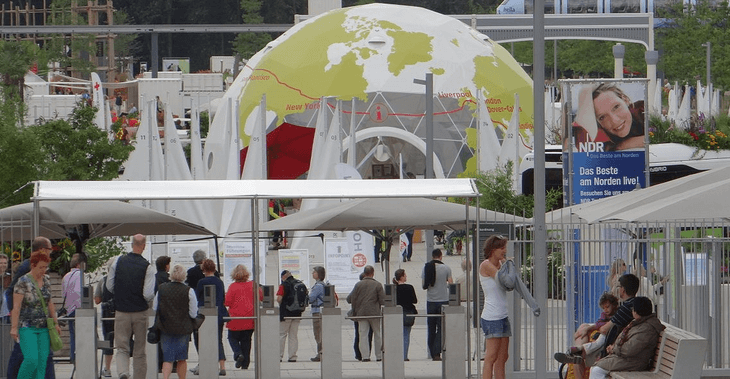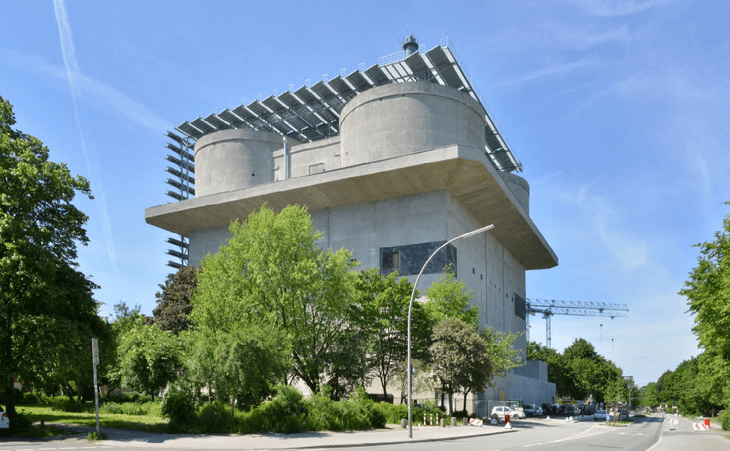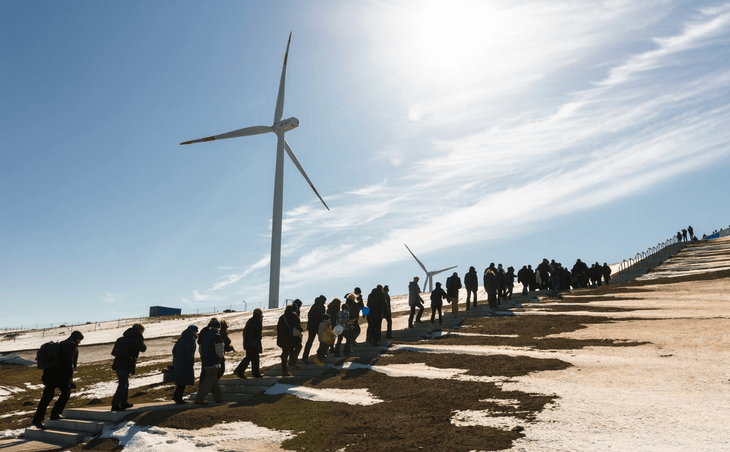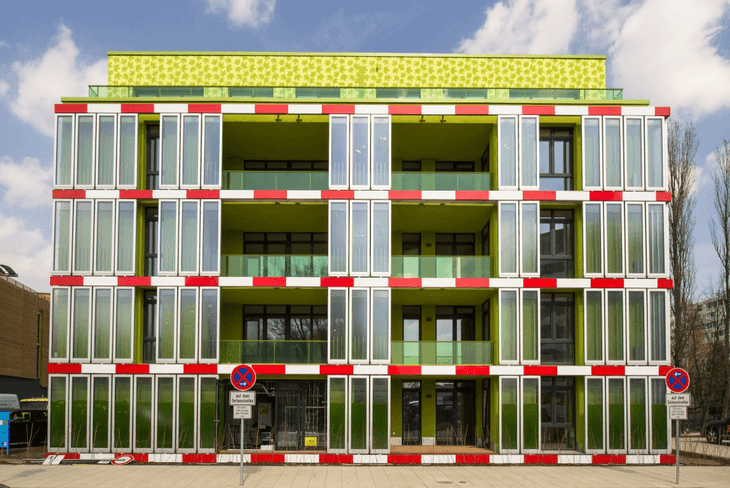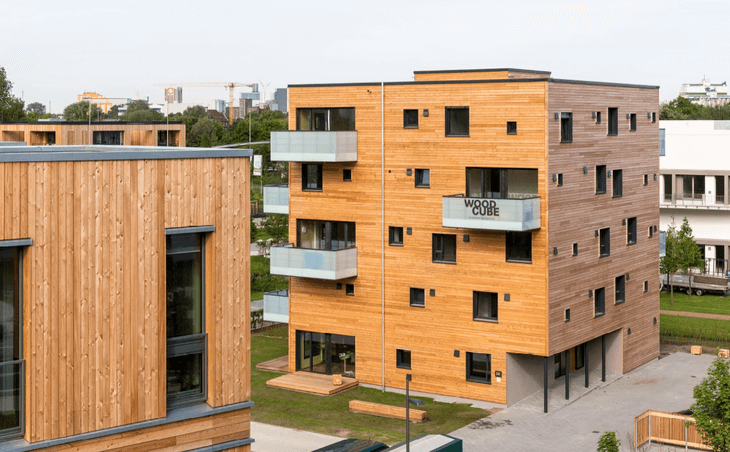In 2005 Hamburg decided to support the redevelopment of the Wilhelmsburg neighborhood through hosting the International Building and the International Garden Show (IBA).
Wilhemsburg has 55,000 inhabitants living in an Island on the Elbe vulnerable to flooding. It is also an ethnically diverse and low income community with an environment affected by industrial and transport infrastructures. To develop the "Climate Protection Concept Renewable Wilhelmsburg" an “IBA Partnership” was first established which brought together 150 private companies and the local community. As a result, over 70 projects were developed around 3 themes including cities and climate change.
The projects are based on maximizing the use of local energy resources such as energy savings and energy efficiency thereby strengthening the local economy as a result. The aim is 100% local renewal supply by 2025 and 100% renewable heat by 2050, making the Elbe Islands carbon neutral. The IBA provided an opportunity and structure to further the scheme. The IBA Hamburg Model and the Climate Protection Renewable Wilhemsburg’s strategy are already being used in other parts of the City. Additionally the IBA is sharing the knowledge generated with other partner Cities.
To support the new urban development program of the City of Hamburg, called “Leap over River Elbe”, and to connect the city centre with the southern city districts, the Hamburg Senate decided in 2005 to present the International Building Exhibition IBA and the International Garden Show igs in the district of Wilhelmsburg. To organize both “shows”, the IBA and the parallel igs, the Hamburg government founded in 2006 two city owned companies linked in terms of structure and management.
The foundation for making the IBA area a more energy efficient environment is the “Climate Protection Concept Renewable Wilhelmsburg”, which was developed by an international committee of experts in collaboration with IBA in the years 2008 to 2010. The idea behind the resulting “Energy Atlas”, is that we need to utilize the city’s (or district’s) local energy resources to supply renewable energy and at the same time to considerably increase the efficiency of local energy consumption. Undertaking several researches and studies, the results demonstrate that it is possible to supply the Elbe Islands by local renewable energy sources by 2050 even if the population will grow from 55,000 up to 73.000. In detail, a 100% supply by renewable power is possible until 2025, a supply of 85% renewable heat until 2050, to make the Elbe Islands nearly carbon neutral until 2050.
It is a typical feature of an IBA to be structurally separated from “normal” administrative units and usually incorporated as a limited liability company. It thus has a certain amount of independence from classic administrative hierarchies and can act more like a private enterprise. Because of the lack of sovereign rights and administrative tasks, IBA has to work with several official administrations of the city and the municipal government as well as with relevant city owned companies. Additionally, IBA organised an official “IBA-partnership” with about 150 companies and institutions being members thereof. Inhabitants were also included in numerous workshops and forums.
After the realization of the IBA exhibition in 2013, a follow-up organization has used the existing competence and network to develop and market several new development areas, both within the borders of the exhibition area (central Wilhelmsburg area, “Haulander Weg”) as well as in areas located outside the former area (“Elbmosaik”, former barrack area “Röttiger-Kaserne”).
The working group undertaking the study “Energy Optimisation of the IBA Hamburg Model Region” (University of Applied Sciences Nordhausen) was working on a district level and used a scenario analyses to compare future energy demand and the potentials for savings, increased efficiency, and the use of renewable energy in the various types of urban building environment on the Elbe Islands. It also recommended the development of strategic measures for the optimisation of energy supplies. IBA and the “Climate Protection Concept Renewable Wilhelmsburg” are named as prototypes for further urban developments within the Hamburg area.
Several universities worked together with a high number of energy supply and distribution companies as well as housing companies and house owner associations to verify the results of the monitoring and to motivate them to cooperate to implement the elements of the climate protection concept.
The main objective of the “Climate Protection Concept Renewable Wilhelmsburg” is to tackle the challenges of global climate change by:
- the development and the implementation of measures “intra muros” (“within the border of the city or districts”),
- energy savings and energy efficiency,
- the use of local renewable energy sources and
- how local economies can be strengthened as a result.
The study undertook a concrete examination of two different reference scenarios, illustrating developments in 2013/2020/2050, and applying Germany-wide trends in renovation, efficiency and the introduction of renewable energy to the Elbe Islands. Two so-called excellence scenarios were developed as alternative to the reference scenarios to incorporate concrete IBA projects and also to examine different areas of emphasis in renewable energy supplies. The two scenarios are local and decentralised solutions adapted to the special local ability to achieve autonomy in renewable energy. The results of the study, undertaken in close cooperation with the IBA’s specialist Energy and Climate Advisory Board, form the most important basis for the “Energy-Atlas” of the Elbe Islands, and represent the strategic instruments and projects of the Elbe Islands’ future energy supply systems. The aim is the presentation of a spatial energy model for the IBA’s demonstration region.
In fact, the results of the study demonstrate that it is possible to supply the Elbe Islands by local renewable energy sources by 2050 even if the population will grow from 55.000 up to 73.000. In detail, a 100% supply by renewable power is possible until 2025, a supply of 85% renewable heat until 2050, to make the Elbe Islands nearly carbon neutral until 2050. The first projects like the “Energy Bunker”, the conversion of a former World War II aircraft shelter into a power station and heat storage and the “Energy Hill”, the transformation of a toxic landfill into a location of wind turbines and PV as well as a public park (see additional information), have been realized in close cooperation with local people and will be continued.
To implement the IBA project, the Hamburg government spent 90 Million Euros on the development of the projects, the coordination of the elements and the implementation of the final event in 2013. Additionally, about 700 Million Euros were spent by private investors to realize the projects it selves.
The already realized or already scheduled projects in 2013 were expected to generate a renewable power production of 54% and a renewable heat production of 14% of the overall demand by the end 2015. After the realization of the IBA projects, a new “Implementation Plan” will be the second Action Plan until 2020 or 2025. It will:
- continue already started IBA projects,
- start the realization of already planned projects,
- transfer existing IBA structures, concepts and networks into a “post IBA period”,
- develop totally new projects, and
- attend the general German and Hamburg development.
The Implementation Plan has to react on the different situations of a development phase without the timeframe, the power and the framework of an IBA. The monitoring of the overall results of the single projects compared to the targets of the concept started in Dec. 2011. It happened in the frame of the project “EnEff:Stadt – IBA Hamburg” of the national program “Energy Efficient City” (“EnEff:Stadt”), conducted by the Technical University Braunschweig, Energy Research Centre Lower Saxony (Energie-Forschungszentrum Niedersachsen, EFZN) and the Hafencity University Hamburg. As European Green Capital 2011, IBA and the “Climate Protection Concept Renewable Wilhelmsburg” made the city one of the frontrunners when it comes to urban interventions to save the environment. Accordingly several thousands of national and international delegations visited IBA and Wilhelmsburg in 2013 and spread the knowledge and the experiences around the globe.
One relevant barrier is the financial situation of house owners which prevents even high economic efficient refurbishments or technical installations. IBA delivered information and consultancy to facilitate the implementation of the measures.
Another barrier are the risks of investments in district heating grids in existing areas with high number of house owners. IBA organized round table discussions as well as joint and integrated planning workshops to achieve best results for all stakeholders.
The IBA Hamburg examines ways in which maximum use can be made of local renewable energy sources “intra muros” (“within the border of the city or districts”), such as energy savings and energy efficiency, and how local economies can be strengthened as a result.
Combined with the evaluation and monitoring concept, the lessons learned will be used to upgrade and adjust the “Climate Protection Concept Renewable Wilhelmsburg” to reach the goals in 2050.
Additionally, IBA is involved in several national and international projects and will share the experiences with the involved partners and cities like Copenhagen, Amsterdam, Vienna, Lyon, Genova, Stockholm, Barcelona and Munich (EU Framework Project TRANSFORM, Interreg IVC Project CLUE,…).
- Hamburg, Germany: The International Building Exhibition IBA Hamburg and its “Climate Protection Concept Renewable Wilhelmsburg”, Guangzhou Award for Urban Innovation, http://cms.guangzhouaward.org/template/view/id/2203/type/content/template_id/87.html (accessed 30 June 2016)
External links / documents
Want to know more about this project?

Related case studies
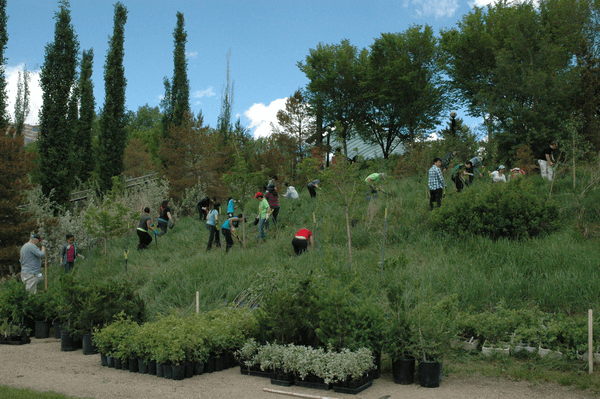
Edmonton, Canada
Urban Forest Management Plan (UFMP)
The Plan provides strategic direction for Edmonton entire urban forest.
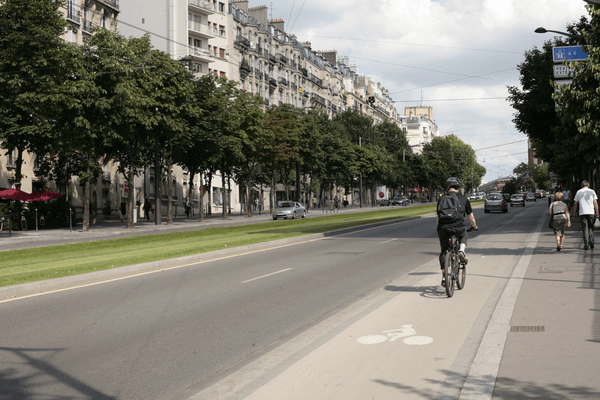
Ile de France, France
Urban Transport Plan for the Ile-de-France Region
The Plan aims to find a better balance between transportation and environmental issues in the metropolitan region of Paris Ile-de-France
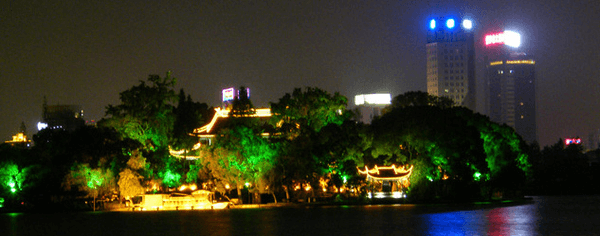
Jiaxing, China
Shijiuyang Ecological Wetland for Safe Drinking...
This practice ensures drinking water safety for residents and promotes continuous improvement in ecological and residential environments.
